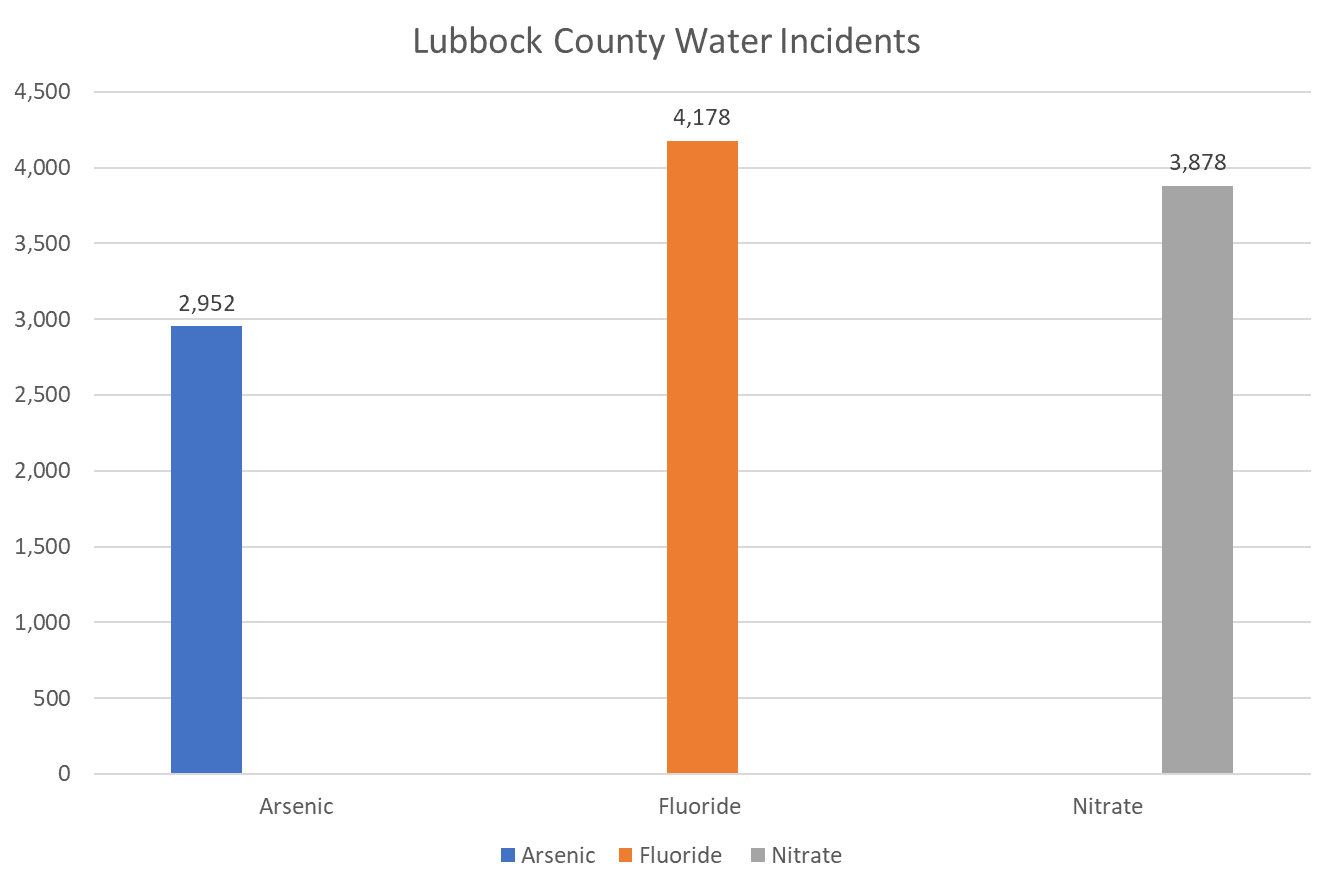What to Know About Your Water - Lubbock County
Unsafe water is dangerous for human health as it is the cause of millions of deaths and illnesses (Landrigan et al., 2018). Water is contaminated through chemicals or hazardous substances that then make it unsafe for consumption. Lubbock county has a history of water violations and unsafe water. Some examples include issues with chemically derived contents such as aluminum, nitrate, arsenic, and fluoride. Certain substances are within regulation, the standards are usually higher than what health experts advise. Other substances are not regulated yet evidence shows they are harmful to human health. For example, studies show that aluminum in drinking water causes numerous health problems such as Alzheimer's disease, weak bones and damage to the nervous system through diffused aluminum ions in the blood plasma. (Krupińska, 2020). The World Health Organization (2017) recommends aluminum levels lower than 0.2 mg/dm3, but 0.1 mg/dm3 is ideal and feasible. The city of Lubbock's (2021) water quality report reveals an average of .131 mg/dm3 and a range of .072 -.190 mg/dm3 which is enough to make it dangerous for those with a higher water consumption. In addition, the city's water system, the Lubbock Public Water System, provides water for over 330,000 people and is the main provider for the city making it critical that the tap water is safe to drink (Texas Commission on Environmental Quality[TCEQ], 2022). Other water systems in Lubbock county serve thousands of people and have had thousands of violations as well (Environmental Protection Agency[EPA], 2022).
Nitrate in drinking water can cause the risk of infant methemoglobinemia, colorectal cancer, thyroid disease, and neural tube defects (Ward et al., 2018). The nitrate comes from inorganic fertilizer, manure, and chemically through stagnation (World Health Organization [WHO], 2017). The WHO guideline recommends 50 mg/l for infant methemoglobinemia and thyroid effects, but don’t take into account cancer or neural tube defects. The water systems in Lubbock county have had over 3,000 incidents with nitrate over the years due to the county being known for its agriculture (Graves, 2019).
Arsenic occurs naturally in the Earth’s crust and is present in natural waters and WHO guidelines suggest a level between 0.01 mg/l (10 µg/l) (WHO, 2017). Long-term exposure puts an individual at risk for multiple types of cancers and diseases such as skin, lung, bladder, and kidney disease and skin changes. The TCEQ (2021) Lubbock Public Water System reports an average level of 1.95 mg/l for arsenic. A rate that is much higher than health experts recommend.
Elevated levels of fluoride in drinking water causes serious effects on skeletal tissue and increases the risk of bone disease (WHO, 2017). The WHO has a guideline value of 1.5 mg/l and a max value of 4 mg/l and in warmer climates a lower value is recommended as water consumption is expected to be higher. The TCEQ (2021) Lubbock Public Water System has an average .866 mg/l. The cause for concern comes from the 4,178 incidents in fluoride from other water systems in the county (EPA, 2022).
Many of these smaller water systems are to blame for the violations in arsenic, fluoride, and nitrate due to a lack of resources (Environmental Integrity Project, 2016). This is an issue as high levels of arsenic found in rural West Texas and small water systems can’t clean up their water. The main water system Lubbock Public Water System has had a total of 3 violations over the years compared to Franklin Water Systems 3 with 1,552 and Seven Estates with 2,672.
Prompt: What other chemicals are dangerous for our health and what are steps individuals can take to protect themselves?
Environmental Protection Agency. (2022). Safe Drinking Water Information System (SDWIS) Federal Reporting Services. https://ordspub.epa.gov/ords/sfdw/sfdw/r/sdwis_fed_reports_public/103?clear=RP
Environmental Protection Agency. (2022). Safe Drinking Water Information System (SDWIS) Federal Reporting Services. https://ordspub.epa.gov/ords/sfdw/sfdw/r/sdwis_fed_reports_public/103?clear=RP
City of Lubbock. (2021). Water Quality Reports.
*BeY3qnt1vVUXQ6pnvCk8fYAqIVE8syPmi1dZcKqS.pdf (lubbock.tx.us)
Environmental Protection Agency. (2022). Safe Drinking Water Information System (SDWIS) Federal Reporting Services. https://ordspub.epa.gov/ords/sfdw/sfdw/r/sdwis_fed_reports_public/103?clear=RP
Environmental Integrity Project. (2016). Don’t Drink the Water.
http://environmentalintegrity.org/wp-content/uploads/Arsenic-Report.pdf
Krupińska I. (2020). Aluminium Drinking Water Treatment Residuals and Their Toxic Impact on Human Health. Molecules (Basel, Switzerland), 25(3), 641. https://doi.org/10.3390/molecules25030641
Texas Commission on Environmental Quality. (2022). Texas Drinking Water Watch
Texas Drinking Water Watch
Lawrence L. Graves. (2019). “Lubbock County,” Handbook of Texas Online.
https://www.tshaonline.org/handbook/entries/lubbock-county.
Landrigan P et al. 2018. The Lancet Commission on Pollution and Health.
Ward, M. H., Jones, R. R., Brender, J. D., de Kok, T. M., Weyer, P. J., Nolan, B. T., Villanueva, C. M., & van Breda, S. G. (2018). Drinking Water Nitrate and Human Health: An Updated Review. International journal of environmental research and public health, 15(7), 1557. https://doi.org/10.3390/ijerph15071557
World Health Organization. (2017). Guidelines for drinking-water quality, 4th edition, incorporating the 1st addendum. https://www.who.int/water_sanitation_health/publications/drinking-water-quality-guidelines-4-including-1st-addendum/en/




Hi Victoria,
ReplyDeleteFrom personal experience, investing in a water filter that attaches to your sink is best. I've lived in a town where the water was terrible and the city didn't do anything about it. Even taking showers didn't seem right because of how bad the water is. There are water filters that can attach to any faucet surface to help with that issue. If finances are an issue, sometimes boiling the water first can help separate those minerals so you can filter them out manually but it is not an easy process.
I was not aware that alzheimers was linked to aluminum and that is definitely concerning given the high usage of this in our every day.
ReplyDelete